Popular focused on a general lens is one point.
(Except for special lenses for precision measurement like telecentric lenses.)
There is a region with less focus blur before and after the point where perfect focus is on.
This is called depth of focus.
When it deviates from a point where it is completely in focus, it gradually blurs. Where is the practical range will be the subjectivity of the individual. By narrowing down the optical path, you can gradually reduce this degree of blurring. However, by narrowing, the image becomes dark, so you can not use it with a lens with a high magnification.
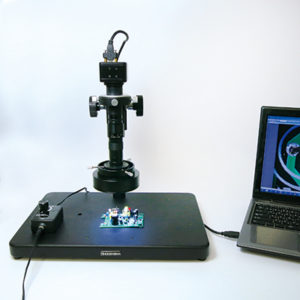 |
The left picture is our company’s USB microscope USB microscope with aris |
Compare the images when opened and narrowed with this irised microscope.
(When you narrow down the aperture, the depth of focus becomes deeper.)
<at 50x>
●Glass scale
Tilt the 0.5 mm pitch glass scale to 45 degrees and observe straight from the top
| <Open the aperture> | <Close maximum aperture> |
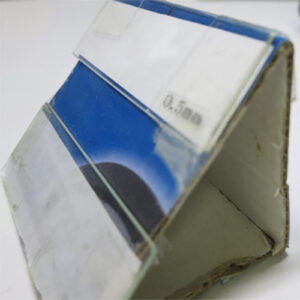 |
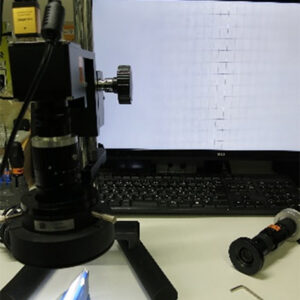 |
Since it is tilted to 45 degrees, it will be the depth of focus if multiplied by 1 / 1.41.
The focus on individuals depends on individual opinions.
If it is judged that 4 pitches (= 2 mm) are matched, 2 mm × (1 / 1.41) = 1.42 mm can be said as the depth of focus.
●For board
Tilt the substrate at 45 degrees and observe it 50 times.
(1.6 mm × 0.8 mm electronic components are lined at 1 mm pitch.)
| <Open the aperture> | <Close maximum aperture> |
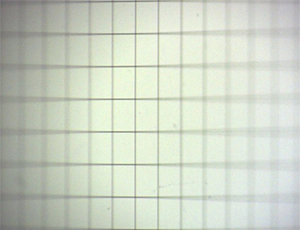 |
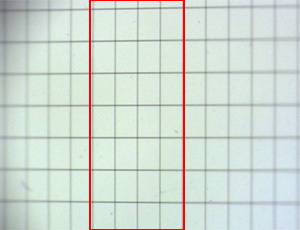 |
<at 100x>
●Glass scale
I also checked the times at 100 times for your reference.
Since the magnification is high, the glass scale has been changed to 0.2 mm pitch
| <Open the aperture> | <Close maximum aperture> |
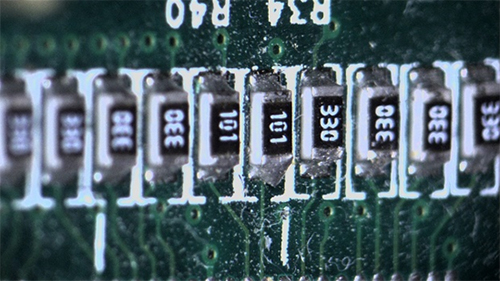 |
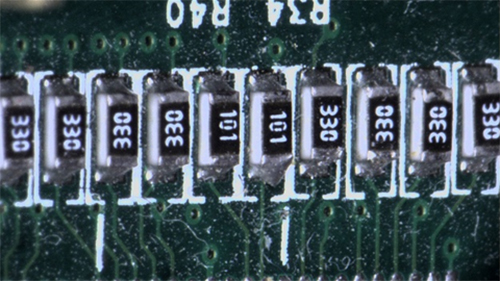 |
if this range is judged as a practical range, focus range is 1.2 mm × (1 / 1.41) = 0.85 mm
Please note that narrowing the aperture will make the lens darker and the resolution will also decrease.
(For details, please refer to “NA (Numerical Aperture)”.)
3.Depth of focus/techniques to increase depth of field
◆Explanation: About lens depth of focus/depth of field
Before introducing the trick, I would like to explain the depth of focus of the lens.
Depth of focus is also expressed as DOF (Depth of Focuse).
|
In air (N=1) DOF=(0.55/(2×NA²))+(1/M×K/NA) |
(Explanation of formula)
The first item is “Item determined by resolution.”
The second item “K” is a “constant determined by the resolution of the observer’s eyes” and varies from person to person.
“M” is the “total magnification of the lens.”
What can be said from this is that in order to deepen the depth of focus,
The only way to do this is to lower the magnification or lower the NA.
At the same magnification, the only option is to lower the NA.
The specifications below are from the same manufacturer and series.
The one on the left is a megapixel compatible lens, and the one on the right is a general-purpose lens with low resolution.

When comparing lenses with the same magnification and focal length, general-purpose lenses have a deeper depth of focus.
The only way to lower the NA with the same lens is to narrow down the aperture.
When using different lenses, if the magnification is the same, the longer focal length is better.
The NA decreases and the depth of focus increases.
◆Introducing tricks: “Aperture” and “Digital zoom”
If it is up to about 50x, you can use “aperture” and “digital zoom” together.
Even a simple microscope made with a fixed focus lens
Achieves deep depth of focus/depth of field.
However, both “aperture” and “digital zoom” tend to reduce resolution.
Use a 4K (8 million pixel) camera and a corresponding high-resolution lens.
It is recommended.
A 4K camera (8 million pixels) with a 50mm lens compatible with 10 million pixels,
I added a close-up ring so that I could take macro shots at 50x magnification and took some comparison shots.
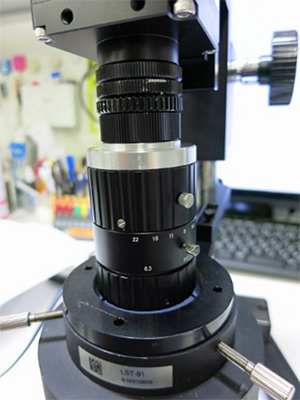
Photographed the same board as above under the same conditions.
(1)At 50x, depth of focus/depth of field can be adjusted just by changing the lens aperture
| <When opening the aperture> | <When fully opened> |
 |
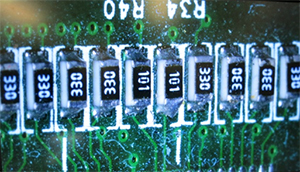 |
(2)After adjusting to achieve 50x magnification with a digital 2x zoom, fine-tuning the aperture of the lens to adjust the depth of field.
| <When opening the aperture> | <When fully opened> |
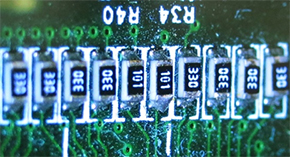 |
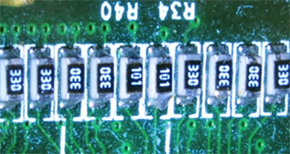 |
(3)The benefits of using this trick:
– Since fixed-focus lenses are used, zooming is not possible.
– However, unlike macro zoom lenses, the working distance is not fixed.
– This flexibility allows for longer working distances (W.D.), system miniaturization, and adjustment of depth of field.
– Depending on the lens selection, you can achieve any fixed magnification ranging from 5x to 50x.”
4.Summary
The depth of field, also known as the zone of acceptable focus, refers to the area with minimal focus blur around a perfectly focused point.
The practical range of depth of field is subjective and varies from person to person.
However, by combining “aperture adjustment” and “digital zoom,” you can achieve a deep depth of field with a simple microscope made using fixed-focus lenses, up to around several times magnification.”



